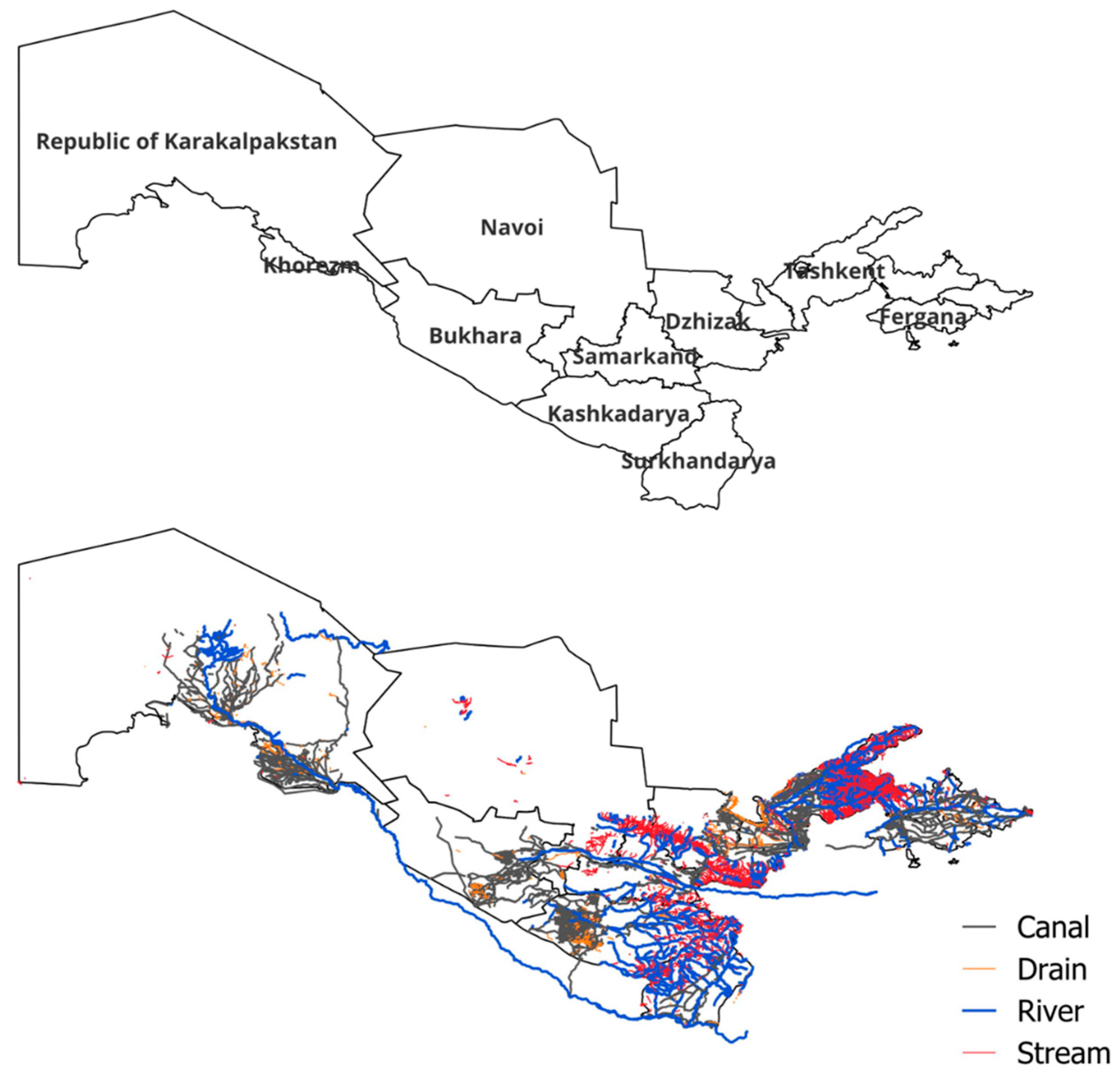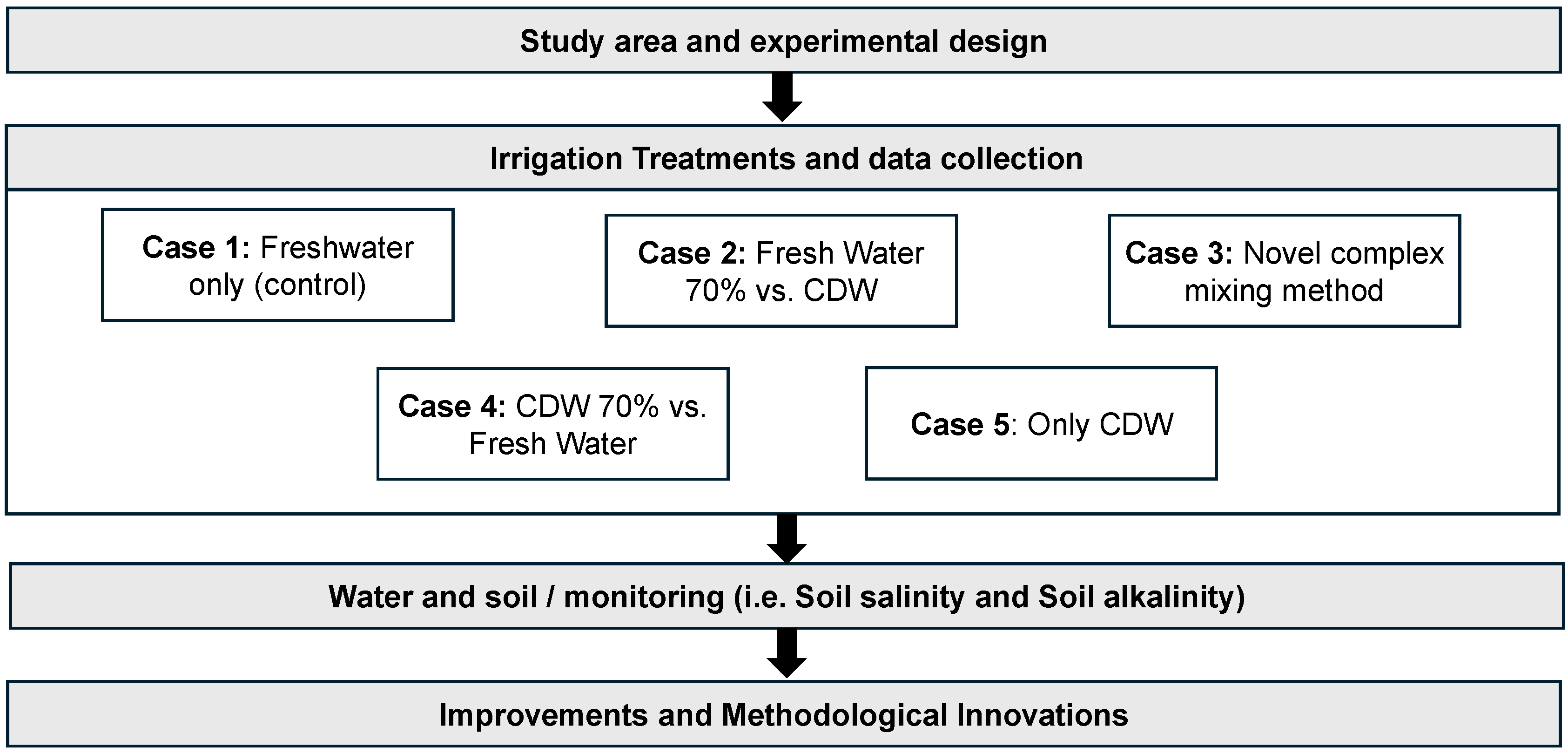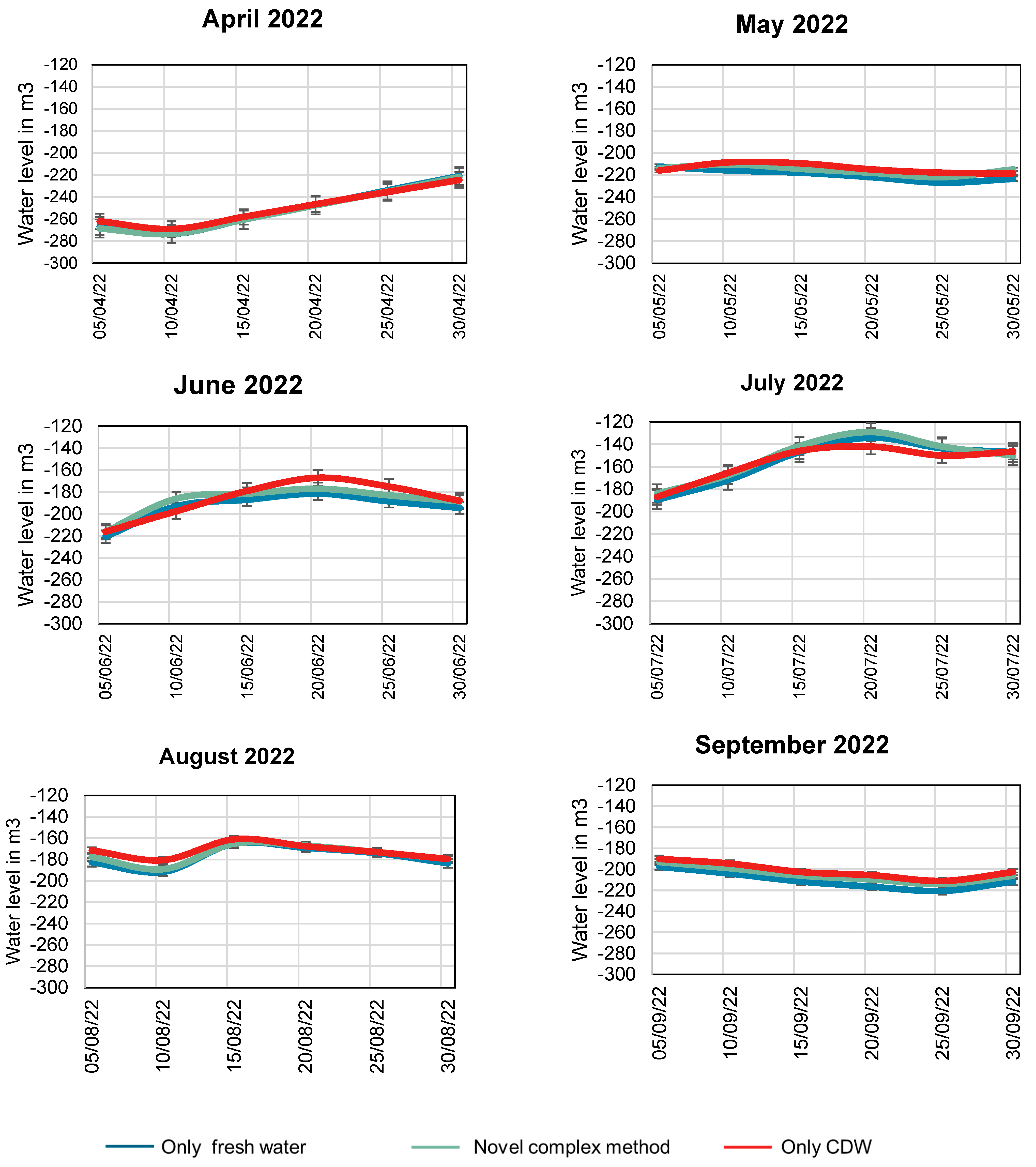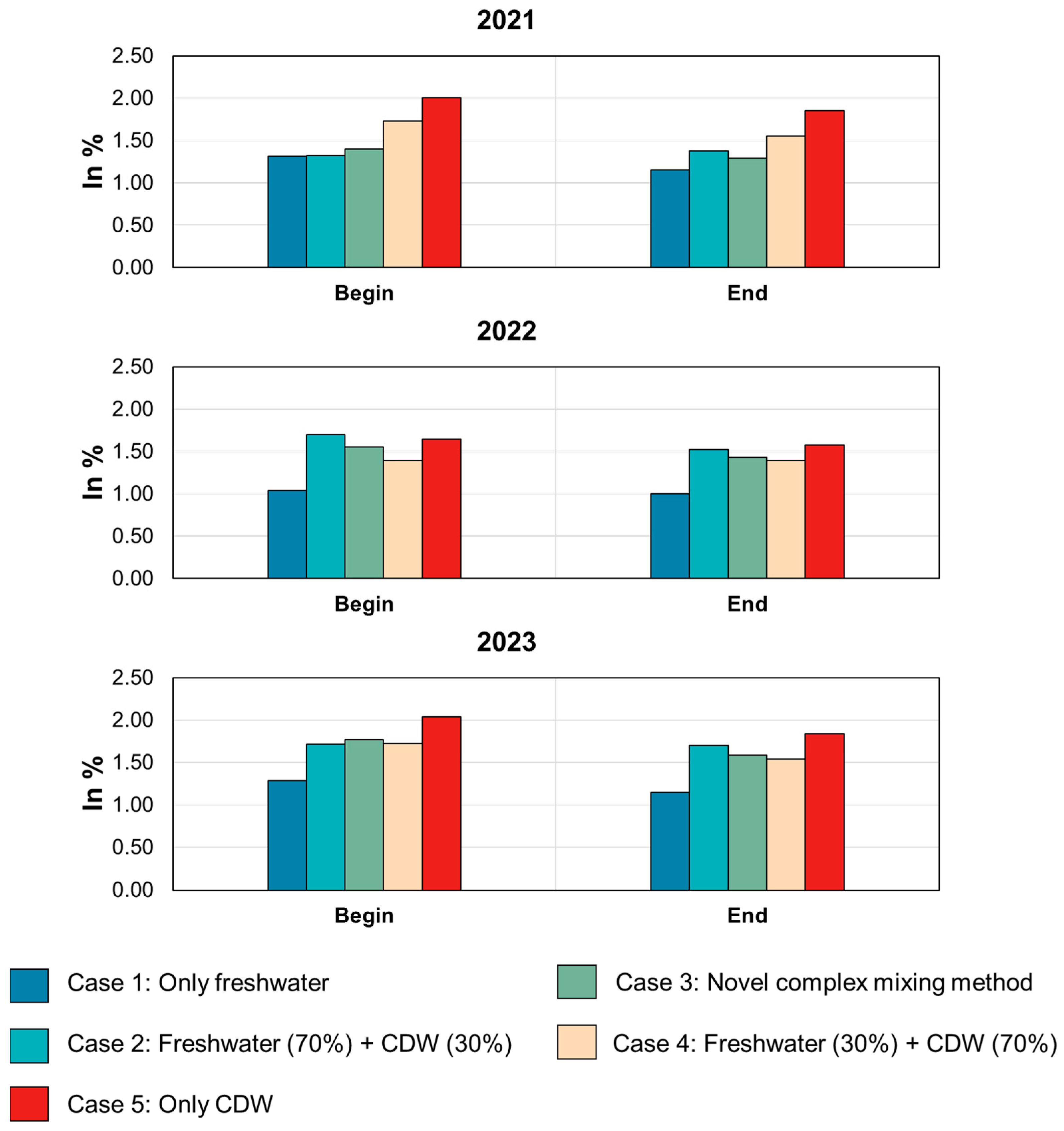The Role of Collector-Drainage Water in Sustainable Irrigation for Agriculture in the Developing World: An Experimental Study
Abstract
1. Introduction
1.1. Background and Context
1.2. Special Focus on Uzbekistan and the State of the Art
1.3. Novelty of the Research
2. Materials and Methods
2.1. Methdology
2.2. Study Area
3. Development of a Novel Complex Mixing Method
- Qirr = Irrigation discharge (m3/s)
- Qcol = Collector Water Discharge as 100% (m3/s)
- Mmix = Mixed mineralization—defined based on research results considering the soil composition and crop types
- Mcan = Mineralization level of surface irrigation water from a canal defined before the irrigation period
- Mirr = The mineralization coefficient, determined before the irrigation period in the irrigation canal, is from 0 to 1.
4. Results of the Experimental Study
4.1. Use of Drainage Water and Soil Salinity
- Fresh Water (FW): 8 rows with 4 protective rows between them (spacing of 0.90 m) and a length of 30 m.
- Fresh Water 70% vs. CDW 30% (Mixing): 8 rows with 4 protective rows between them (spacing of 0.90 m) and a length of 30 m.
- Complex Method (Mixing with Specific Rules): 8 rows with 4 protective rows between them (spacing of 0.90 m) and a length of 30 m.
- CDW 70% vs. Fresh Water 30% (Mixing): 8 rows with 4 protective rows between them (spacing of 0.90 m) and a length of 30 m.
- Collector-Drainage Water (CDW): 8 rows with 4 protective rows between them (spacing of 0.90 m) and a length of 30 m.
4.2. Yield Comparison Across Experimental Variants
5. Outlook and Limitation of the Study
6. Conclusions
Author Contributions
Funding
Institutional Review Board Statement
Informed Consent Statement
Data Availability Statement
Conflicts of Interest
References
- Morante-Carballo, F.; Montalván-Burbano, N.; Quiñonez-Barzola, X.; Jaya-Montalvo, M.; Carrión-Mero, P. What Do We Know About Water Scarcity in Semi-Arid Zones? A Global Analysis and Research Trends. Water 2022, 14, 2685. [Google Scholar] [CrossRef]
- Karimi, M.; Tabiee, M.; Karami, S.; Karimi, V.; Karamidehkordi, E. Climate change and water scarcity impacts on sustainability in semi-arid areas: Lessons from the South of Iran. Groundw. Sustain. Dev. 2024, 24, 101075. [Google Scholar] [CrossRef]
- Mehta, K.; Ehrenwirth, M.; Trinkl, C.; Zörner, W.; Greenough, R. The Energy Situation in Central Asia: A Comprehensive Energy Review Focusing on Rural Areas. Energies 2021, 14, 2805. [Google Scholar] [CrossRef]
- Wang, X.; Chen, Y.; Fang, G.; Li, Z.; Liu, Y. The growing water crisis in Central Asia and the driving forces behind it. J. Clean. Prod. 2022, 378, 134574. [Google Scholar] [CrossRef]
- Ingrao, C.; Strippoli, R.; Lagioia, G.; Huisingh, D. Water scarcity in agriculture: An overview of causes, impacts and approaches for reducing the risks. Heliyon 2023, 9, e18507. [Google Scholar] [CrossRef]
- Gomiero, T. Soil Degradation, Land Scarcity and Food Security: Reviewing a Complex Challenge. Sustainability 2016, 8, 281. [Google Scholar] [CrossRef]
- Dukhovny, V.A.; Sokolov, V.I.; Ziganshina, D.R. Integrated Water Resources Management in Central Asia, as a way of survival in conditions of water scarcity. Quat. Int. 2013, 311, 181–188. [Google Scholar] [CrossRef]
- Lakhiar, I.A.; Yan, H.; Zhang, C.; Wang, G.; He, B.; Hao, B.; Han, Y.; Wang, B.; Bao, R.; Syed, T.N.; et al. A Review of Precision Irrigation Water-Saving Technology under Changing Climate for Enhancing Water Use Efficiency, Crop Yield, and Environmental Footprints. Agriculture 2024, 14, 1141. [Google Scholar] [CrossRef]
- Duanbekova, A.; Tokbergenova, A.; Sultanbekova, P.; Essanbekov, M.; Zulpykharov, K.; Sarkynov, Y.; Taukebayev, O.; Kaliyeva, D.; Kozhabekova, Z. Collector-drainage water reuse for crop irrigation: Experiment on saline lands of southern Kazakhstan. Soil Sci. Ann. 2024, 75, 1–13. [Google Scholar] [CrossRef]
- Didovets, I.; Lobanova, A.; Krysanova, V.; Menz, C.; Babagalieva, Z.; Nurbatsina, A.; Gavrilenko, N.; Khamidov, V.; Umirbekov, A.; Qodirov, S.; et al. Central Asian rivers under climate change: Impacts assessment in eight representative catchments. J. Hydrol. Reg. Stud. 2021, 34, 100779. [Google Scholar] [CrossRef]
- Mehta, K.; Ehrenwirth, M.; Zörner, W.; Greenough, R. Need of energy transition at roof of the world: Correlative approach to interpret energy identity of high-altitude Central Asian communities. Energy Sustain. Dev. 2023, 76, 101271. [Google Scholar] [CrossRef]
- Abdullaev, I. The Analysis of Water Management in Bukhara Oasis of Uzbekistan: Historical and Territorial Trends. Water Int. 2004, 29, 20–26. [Google Scholar] [CrossRef]
- Khamidov, M.; Ishchanov, J.; Khamidova, S.; Isabaev, K.; Altmishev, A. Water scarcity under global climate change: Ways of addressing water scarcity in the Amu Darya lower reaches. IOP Conf. Ser. Earth Environ. Sci. 2023, 1138, 12008. [Google Scholar] [CrossRef]
- Dukhovny, V.A.; de Schutter, J. Water in Central Asia; CRC Press: Boca Raton, FL, USA, 2011; ISBN 9780429299926. [Google Scholar]
- Usmanov, S.; Yakubov, M.; Mirkhasilova, Z.; Irmukhomedova, L.; Babakulova, L. The ways of using collector drainage waters for irrigation. E3S Web Conf. 2023, 365, 1018. [Google Scholar] [CrossRef]
- Chen, Y.; Zhang, J.-H.; Chen, M.-X.; Zhu, F.-Y.; Song, T. Optimizing water conservation and utilization with a regulated deficit irrigation strategy in woody crops: A review. Agric. Water Manag. 2023, 289, 108523. [Google Scholar] [CrossRef]
- Nikolaou, G.; Neocleous, D.; Christou, A.; Kitta, E.; Katsoulas, N. Implementing Sustainable Irrigation in Water-Scarce Regions under the Impact of Climate Change. Agronomy 2020, 10, 1120. [Google Scholar] [CrossRef]
- Dukhovny, V.A.; Stulina, G. Strategy of transboundary return flow use in the Aral Sea basin. Desalination 2001, 139, 299–304. [Google Scholar] [CrossRef]
- Kulmatov, R.; Groll, M.; Rasulov, A.; Soliev, I.; Romic, M. Status quo and present challenges of the sustainable use and management of water and land resources in Central Asian irrigation zones—The example of the Navoi region (Uzbekistan). Quat. Int. 2018, 464, 396–410. [Google Scholar] [CrossRef]
- Sutton, W.R.; Srivastava, J.P.; Neumann, J.E.; Droogers, P.; Boehlert, B. Reducing the Vulnerability of Uzbekistan’s Agricultural Systems to Climate Change; The World Bank: Washington, DC, USA, 2013; ISBN 978-1-4648-0000-9. [Google Scholar]
- Mirzaqobulov, J.; Salokhiddinov, A.; Mamatov, S. Exploring the Potential for Collector-Drainage Water Reuse in Fodder Crop Farming: A Case Study in Uzbekistan’s Mizachul Steppe. E3S Web Conf. 2023, 386, 2006. [Google Scholar] [CrossRef]
- Devkota, M.; Martius, C.; Gupta, R.K.; Devkota, K.P.; McDonald, A.J.; Lamers, J. Managing soil salinity with permanent bed planting in irrigated production systems in Central Asia. Agric. Ecosyst. Environ. 2015, 202, 90–97. [Google Scholar] [CrossRef]
- Dustnazarova, S.; Khasanov, A.; Khafizova, Z.; Davronov, K. The threat of saline lands, for example, in the Republic of Uzbekistan. E3S Web Conf. 2021, 284, 2002. [Google Scholar] [CrossRef]
- Pool, S.; Francés, F.; Garcia-Prats, A.; Puertes, C.; Pulido-Velazquez, M.; Sanchis-Ibor, C.; Schirmer, M.; Yang, H.; Jiménez-Martínez, J. Impact of a transformation from flood to drip irrigation on groundwater recharge and nitrogen leaching under variable climatic conditions. Sci. Total Environ. 2022, 825, 153805. [Google Scholar] [CrossRef] [PubMed]
- Salokhiddinov, A.; Boirov, R.; Ismailov, M.; Mamatov, S.; Khakimova, P.; Rakhmatullaeva, M. Climate change effects on irrigated agriculture: Perspectives from agricultural producers in eastern Uzbekistan. IOP Conf. Ser. Earth Environ. Sci. 2020, 612, 12058. [Google Scholar] [CrossRef]
- Liu, Y.; Hu, Y.; Wei, C.; Zeng, W.; Huang, J.; Ao, C. Synergistic regulation of irrigation and drainage based on crop salt tolerance and leaching threshold. Agric. Water Manag. 2024, 292, 108679. [Google Scholar] [CrossRef]
- Tarolli, P.; Luo, J.; Park, E.; Barcaccia, G.; Masin, R. Soil salinization in agriculture: Mitigation and adaptation strategies combining nature-based solutions and bioengineering. iScience 2024, 27, 108830. [Google Scholar] [CrossRef]
- Wang, D.; Zhao, C.; Zheng, J.; Zhu, J.; Gui, Z.; Yu, Z. Evolution of soil salinity and the critical ratio of drainage to irrigation (CRDI) in the Weigan Oasis in the Tarim Basin. CATENA 2021, 201, 105210. [Google Scholar] [CrossRef]
- Datta, K.; Jong, C. Adverse effect of waterlogging and soil salinity on crop and land productivity in northwest region of Haryana, India. Agric. Water Manag. 2002, 57, 223–238. [Google Scholar] [CrossRef]
- Wichelns, D. An economic model of waterlogging and salinization in arid regions. Ecol. Econ. 1999, 30, 475–491. [Google Scholar] [CrossRef]
- Litalien, A.; Zeeb, B. Curing the earth: A review of anthropogenic soil salinization and plant-based strategies for sustainable mitigation. Sci. Total Environ. 2020, 698, 134235. [Google Scholar] [CrossRef]
- Muhammad, M.; Waheed, A.; Wahab, A.; Majeed, M.; Nazim, M.; Liu, Y.-H.; Li, L.; Li, W.-J. Soil salinity and drought tolerance: An evaluation of plant growth, productivity, microbial diversity, and amelioration strategies. Plant Stress 2024, 11, 100319. [Google Scholar] [CrossRef]
- van den Burg, S.; Deolu-Ajayi, A.O.; Nauta, R.; Cervi, W.R.; van der Werf, A.; Poelman, M.; Wilbers, G.-J.; Snethlage, J.; van Alphen, M.; van der Meer, I.M. Knowledge gaps on how to adapt crop production under changing saline circumstances in the Netherlands. Sci. Total Environ. 2024, 915, 170118. [Google Scholar] [CrossRef] [PubMed]
- Navarro-Torre, S.; Garcia-Caparrós, P.; Nogales, A.; Abreu, M.M.; Santos, E.; Cortinhas, A.L.; Caperta, A.D. Sustainable agricultural management of saline soils in arid and semi-arid Mediterranean regions through halophytes, microbial and soil-based technologies. Environ. Exp. Bot. 2023, 212, 105397. [Google Scholar] [CrossRef]
- Bwambale, E.; Abagale, F.K.; Anornu, G.K. Smart irrigation monitoring and control strategies for improving water use efficiency in precision agriculture: A review. Agric. Water Manag. 2022, 260, 107324. [Google Scholar] [CrossRef]
- Zhou, Q.; Zhang, Y.; Wu, F. Evaluation of the most proper management scale on water use efficiency and water productivity: A case study of the Heihe River Basin, China. Agric. Water Manag. 2021, 246, 106671. [Google Scholar] [CrossRef]
- Karimzadeh, S.; Hartman, S.; Chiarelli, D.D.; Rulli, M.C.; D’Odorico, P. The tradeoff between water savings and salinization prevention in dryland irrigation. Adv. Water Resour. 2024, 183, 104604. [Google Scholar] [CrossRef]
- Wichelns, D.; Qadir, M. Achieving sustainable irrigation requires effective management of salts, soil salinity, and shallow groundwater. Agric. Water Manag. 2015, 157, 31–38. [Google Scholar] [CrossRef]
- Stavi, I.; Thevs, N.; Priori, S. Soil Salinity and Sodicity in Drylands: A Review of Causes, Effects, Monitoring, and Restoration Measures. Front. Environ. Sci. 2021, 9, 712831. [Google Scholar] [CrossRef]
- Chávez-García, E.; Siebe, C. Rehabilitation of a highly saline-sodic soil using a rubble barrier and organic amendments. Soil Tillage Res. 2019, 189, 176–188. [Google Scholar] [CrossRef]
- Bello, S.K.; Alayafi, A.H.; AL-Solaimani, S.G.; Abo-Elyousr, K.A.M. Mitigating Soil Salinity Stress with Gypsum and Bio-Organic Amendments: A Review. Agronomy 2021, 11, 1735. [Google Scholar] [CrossRef]
- Mishra, S.; Kumar, R.; Kumar, M. Use of treated sewage or wastewater as an irrigation water for agricultural purposes- Environmental, health, and economic impacts. Total Environ. Res. Themes 2023, 6, 100051. [Google Scholar] [CrossRef]
- Anarbekov, O.; Gaipnazarov, N.; Akramov, I.; Djumaboev, K.; Gafurov, Z.; Solieva, U.; Khodjaev, S.; Eltazarov, S.; Tashmatova, M. Overview of Existing River Basins in Uzbekistan and the Selection of Pilot Basins. [Project Report of the Sustainable Management of Water Resources in Rural Areas in Uzbekistan. Component 1: National Policy Framework for Water Governance and Integrated Water Resources Management and Supply Part]; IWMI: Colombo, Sri Lanka, 2018. [Google Scholar]
- Ungureanu, N.; Vlăduț, V.; Voicu, G. Water Scarcity and Wastewater Reuse in Crop Irrigation. Sustainability 2020, 12, 9055. [Google Scholar] [CrossRef]
- Hamidov, A.; Kasymov, U.; Djumaboev, K.; Paul, C. Rebound Effects in Irrigated Agriculture in Uzbekistan: A Stakeholder-Based Assessment. Sustainability 2022, 14, 8375. [Google Scholar] [CrossRef]
- Cheng, M.; Wang, H.; Fan, J.; Wang, X.; Sun, X.; Yang, L.; Zhang, S.; Xiang, Y.; Zhang, F. Crop yield and water productivity under salty water irrigation: A global meta-analysis. Agric. Water Manag. 2021, 256, 107105. [Google Scholar] [CrossRef]
- De Paz, J.M.; Visconti, F.; Zapata, R.; Sánchez, J. Integration of two simple models in a geographical information system to evaluate salinization risk in irrigated land of the Valencian Community, Spain. Soil Use Manag. 2004, 20, 333–342. [Google Scholar] [CrossRef]
- Thorslund, J.; Bierkens, M.F.P.; Oude Essink, G.H.P.; Sutanudjaja, E.H.; van Vliet, M.T.H. Common irrigation drivers of freshwater salinisation in river basins worldwide. Nat. Commun. 2021, 12, 4232. [Google Scholar] [CrossRef]
- Benaafi, M.; Pradipta, A.; Tawabini, B.; Al-Areeq, A.M.; Bafaqeer, A.; Humphrey, J.D.; Nazal, M.K.; Aljundi, I.H. Suitability of treated wastewater for irrigation and its impact on groundwater resources in arid coastal regions: Insights for water resources sustainability. Heliyon 2024, 10, e29320. [Google Scholar] [CrossRef]
- Anyango, G.W.; Bhowmick, G.D.; Sahoo Bhattacharya, N. A critical review of irrigation water quality index and water quality management practices in micro-irrigation for efficient policy making. Desalin. Water Treat. 2024, 318, 100304. [Google Scholar] [CrossRef]
- Mirkhasilova, Z.; Irmuhamedova, L.; Kasymbetova, S.; Akhmedjanova, G.; Mirkhosilova, M. Rational use of collector-drainage water. IOP Conf. Ser. Mater. Sci. Eng. 2020, 883, 12092. [Google Scholar] [CrossRef]
- Stepanov, I.N.; Chembarisov, E.I. Irrigation effect on the mineralization of river waters. Water Air Soil Pollut. 1978, 9, 397–401. [Google Scholar] [CrossRef]









| 2021 | 2022 | 2023 | ||||||||||
|---|---|---|---|---|---|---|---|---|---|---|---|---|
| Irrigation Rate m3/ha | Drainage Water Use | Irrigation Rate m3/ha | Drainage Water Use | Irrigation Rate m3/ha | Drainage Water Use | |||||||
| Gross | Net | Reset | m3/ha | Gross | Net | Reset | m3/ha | Gross | Net | Reset | m3/ha | |
| Only fresh water | 872 | 702 | 170 | 0 | 1173 | 996 | 178 | 0 | 741 | 564 | 170 | 0 |
| 1018 | 839 | 179 | 0 | 918 | 777 | 141 | 0 | 1010 | 840 | 170 | 0 | |
| 894 | 724 | 170 | 0 | 894 | 757 | 138 | 0 | 904 | 734 | 170 | 0 | |
| 951 | 781 | 170 | 0 | 883 | 751 | 132 | 0 | 895 | 733 | 162 | 0 | |
| Fresh Water 70% vs. CDW 30% (Mixing) | 872 | 702 | 170 | 0 | 1173 | 996 | 178 | 0 | 741 | 564 | 170 | 0 |
| 1018 | 839 | 179 | 305 | 918 | 786 | 132 | 275 | 1010 | 840 | 170 | 303 | |
| 894 | 724 | 170 | 268 | 894 | 763 | 131 | 268 | 904 | 734 | 170 | 271 | |
| 951 | 781 | 170 | 285 | 886 | 765 | 121 | 266 | 895 | 733 | 162 | 269 | |
| Novel complex mixing method | 872 | 702 | 170 | 0 | 1173 | 996 | 178 | 0 | 741 | 564 | 170 | 0 |
| 1018 | 839 | 179 | 448 | 930 | 790 | 139 | 521 | 1010 | 840 | 170 | 283 | |
| 894 | 724 | 170 | 340 | 906 | 768 | 138 | 308 | 904 | 734 | 170 | 298 | |
| 951 | 781 | 170 | 485 | 894 | 754 | 141 | 510 | 895 | 733 | 162 | 403 | |
| CDW 70% vs. Fresh Water 30% (Mixing): | 872 | 702 | 170 | 0 | 1173 | 996 | 178 | 0 | 741 | 564 | 170 | 0 |
| 1018 | 839 | 179 | 713 | 951 | 821 | 130 | 666 | 1010 | 840 | 170 | 707 | |
| 894 | 724 | 170 | 626 | 922 | 777 | 145 | 645 | 904 | 734 | 170 | 633 | |
| 951 | 781 | 170 | 666 | 918 | 783 | 135 | 643 | 895 | 733 | 162 | 627 | |
| Only CDW | 872 | 702 | 170 | 0 | 1173 | 996 | 178 | 0 | 741 | 564 | 170 | 0 |
| 1018 | 839 | 179 | 1018 | 942 | 804 | 138 | 942 | 1010 | 840 | 170 | 1010 | |
| 894 | 724 | 170 | 894 | 918 | 780 | 138 | 918 | 904 | 734 | 170 | 904 | |
| 951 | 781 | 170 | 951 | 918 | 779 | 139 | 918 | 895 | 733 | 162 | 895 | |
Disclaimer/Publisher’s Note: The statements, opinions and data contained in all publications are solely those of the individual author(s) and contributor(s) and not of MDPI and/or the editor(s). MDPI and/or the editor(s) disclaim responsibility for any injury to people or property resulting from any ideas, methods, instructions or products referred to in the content. |
© 2024 by the authors. Licensee MDPI, Basel, Switzerland. This article is an open access article distributed under the terms and conditions of the Creative Commons Attribution (CC BY) license (https://creativecommons.org/licenses/by/4.0/).
Share and Cite
Mirzaqobulov, J.; Mehta, K.; Ilyas, S.; Salokhiddinov, A. The Role of Collector-Drainage Water in Sustainable Irrigation for Agriculture in the Developing World: An Experimental Study. World 2025, 6, 1. https://doi.org/10.3390/world6010001
Mirzaqobulov J, Mehta K, Ilyas S, Salokhiddinov A. The Role of Collector-Drainage Water in Sustainable Irrigation for Agriculture in the Developing World: An Experimental Study. World. 2025; 6(1):1. https://doi.org/10.3390/world6010001
Chicago/Turabian StyleMirzaqobulov, Jakhongirmirzo, Kedar Mehta, Sana Ilyas, and Abdulkhakim Salokhiddinov. 2025. "The Role of Collector-Drainage Water in Sustainable Irrigation for Agriculture in the Developing World: An Experimental Study" World 6, no. 1: 1. https://doi.org/10.3390/world6010001
APA StyleMirzaqobulov, J., Mehta, K., Ilyas, S., & Salokhiddinov, A. (2025). The Role of Collector-Drainage Water in Sustainable Irrigation for Agriculture in the Developing World: An Experimental Study. World, 6(1), 1. https://doi.org/10.3390/world6010001






